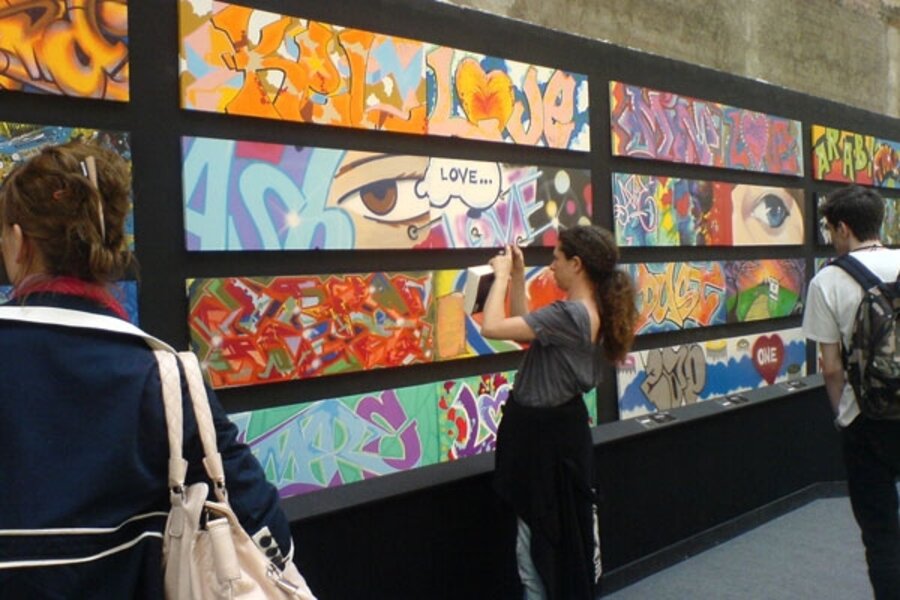In Paris in spring, thoughts turn to ... the art show
Loading...
PARIS – When the economic going gets tough, Parisians appear to go to museums – to exhibitions, more precisely. Europe is in a global financial crisis. But Paris isn’t letting a crisis go to waste. Like a business rediscovering its core competency, the city of light is using its famed spring to do what it does best – the art show. No fewer than 12 major exhibitions have opened in recent weeks, a veritable tsunami of culture.
There aren’t many cities where you can see Andy Warhol’s first retrospective in years, walk a half-block for 90 “graffiti artists” from Taiwan to Europe, then literally cross the street and wander among the visionary works of William Blake – his Job, Moses, the Ancient of Days, and “Tyger Tyger burning bright” – all before lunch.
Then there is an anthropological look at a century of jazz – ragtime to bebop to boogie woogie, and beyond at the Quai Branly Museum, former President Jacques Chirac’s gift to the city. At the Pompidou Center, Alexander Calder and Wassily Kandinsky. Or, try “Forgetting Rodin” at the Orsay, a show of AugusteRodin’s artistic contemporaries that the great sculptor apparently didn’t entirely eclipse. The Bibliotheque Nationale features “Controversies” – famous photographs in some way scandalous, stolen, fraudulent, or otherwise contested, including Abu Ghraib shots, Lewis Hine's famous "Three Riveters: Empire State Building," now said to be staged, and others. The show’s cover iconography is a kiss between a priest and a French nun, who is in full-winged white traditional head gear.
The reputed worry in the Culture Ministry here, prior to the great spring art earthquake, is that locals might cut back and stay home. But Parisians aren’t arguing post-modern economics on the Left Bank; they are lining up at museums, particularly the Warhol (120,000 tickets in 24 days), in record numbers.
Americans supposedly go to the ballpark and buy hot dogs to forget their wounded 401(k)s. Here, they ride the metro to the Louvre. As one museum official told Le Monde, “In times of crisis, people need the emotional compensation of nearness.”
That probably translates into great doses of aesthetic meaning for the human soul. But it can also be taken literally: Paris exhibits at the Branly, Orsay, Pompidou, the Petit Palais and Grand Palais, and the Paris Museum of Modern Art, among others, are all clustered within walking distance – something few cities can boast. And in the Paris spring, it’s a nice walk.
France is also looking to other forms of culture. Attracting Hollywood, shockingly, is one. Pending an EU decision in Brussels, the French government is preparing to subsidize overseas film production and roll back restrictive costs – a stricture once thought to be as much a snub to the Hollywood style as to protecting an industry.
Patrick Lamassoure, managing director of Film France, told The New York Times: “In our world, this is making history…. It will change perceptions of France as defensive about its cultural patrimony.”
The measure will cost about €33 million, but is expected to attract some €240 million in revenue, according to the Times.
The Warhol show, which brings several hundred of the artist's Kodak-induced portraits together in one place, is billed as the first such show since the Whitney in 1979.
This week, among the locals who stood much longer than 15 minutes in line for Warhol, was a Paris senior who brought his two grandsons. He’d seen Warhol, impresario of celebrity art, decades earlier in New York and had a “negative prejudice” against the son of Slovak immigrants, who moved from bohemian to jet-set New York celebrity whose portraits earned him a million dollars a year at a time when that was real money. But this time the Parisian was impressed, seeing “a new side to Warhol. He’s not just commercial, but inherently political and vibrant…. I also find it interesting that the best portraits of Mao and Lenin were done by an American.”
French traditionally love museums, some saying they visit them all over Europe – to find a predominant number of other French also inside. Parisians interviewed at six different exhibits last week said they went as a family activity. At a show on 19th-century early photography of Italy at the Orsay, visits ranged from interest in Italy, to interest in photography, to one elderly man who said, “I see every exhibition I can. I love them.” During interviews, several Parisians spoke of at least three other exhibitions, including on Italian primitive art, not found in the marquee brochures.
Mild breezy and brilliant blue sunny weather also played a role this week, some said. It has been a long winter.





